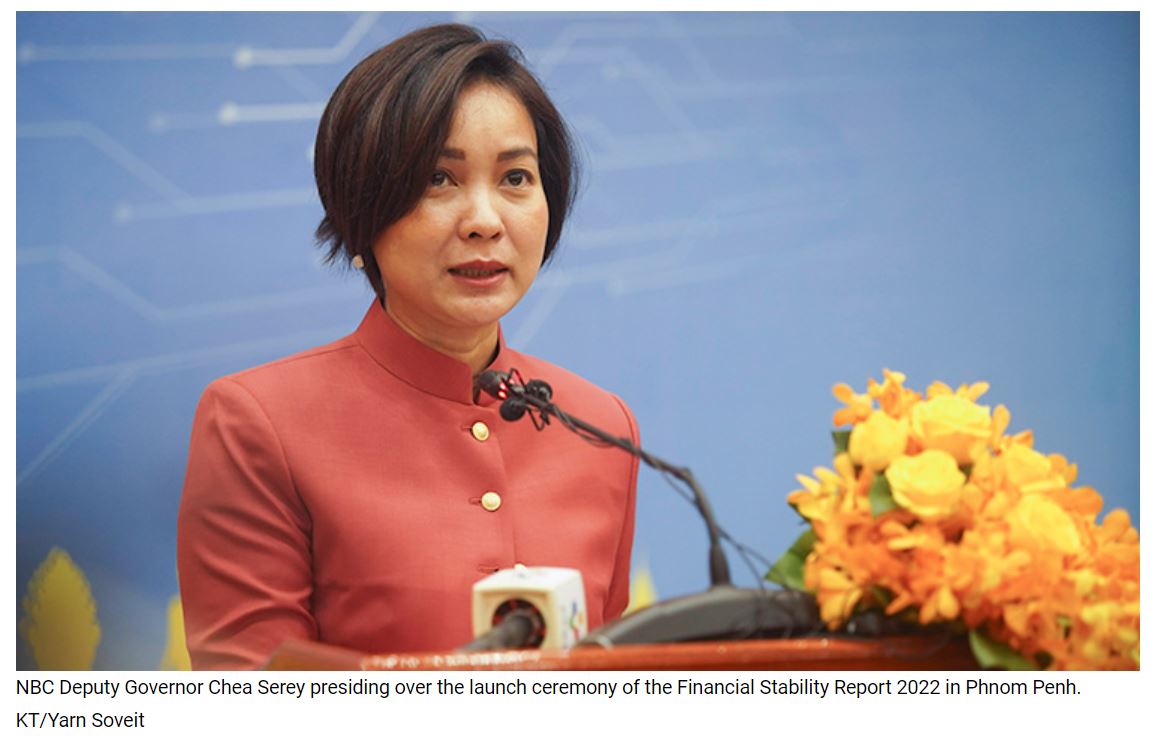Cambodia: Kingdom’s GDP revised to 5.5% amid risks in real estate
National Bank of Cambodia (NBC) has revised Cambodia’s Gross Domestic Product (GDP) growth to 5.5 percent from 5.6 percent for 2023, while the banking system’s stability has been maintained and the non-banking industries have grown gradually even though external have negatively affected the real estate sector, said an NBC’s officials.
The revised economic growth figure was revealed yesterday by NBC Deputy Governor Chea Serey, who presided over the launching ceremony of the Financial Stability Report (FSR) 2022—the fifth since 2018—and attended by more than 250 national and international guests representing financial industries at the Center for Banking Studies in Phnom Penh.
Participants in the event included Raymond Sia, Chairman of the Association of Banks in Cambodia (ABC), Sok Voeun, Chairman of Cambodia Microfinance Association (CMA), Leang Phuong Bunnarath, Director of the Department of Policy of General Secretariat of the Non-Bank Financial Services Authority and officials from different development partners.
Serey said Cambodia’s economy is projected to grow by 5.5 percent in 2023, which has been mainly supported by exports of garment and non-garment manufacturing products, fast recovery in tourism and strong growth in transport and communication, while agriculture may continue to grow slowly along with some risks may affect the country’s financial stability.
Serey said that riel depreciated slightly by about 1 percent in 2022 to stay at 4,102 riel per US dollar on average on annual basis, but the country’s international reserves were still sufficient to cover seven months of prospective imports of goods and services, higher than the three-month minimum benchmark for developing economies, while the inflation is expected to fall to approximately 2 percent this year.
“Another factor that I want to add is that … there might be slower demand in the real estate sector such as houses ahead, which requires prudentially monitoring lending this sector,” said Serey, adding that the real estate sector has grown dramatically for the last ten years, but the lasting real estate crisis in China that has impeded the inflow of Chinese investments into this sector.
NBC has been implementing crisis-exit measures by prudentially re-enhancing the regulations to strengthen the resilience of the banking system in Cambodia, while supporting prioritised sectors such as small and medium enterprises or SME, agriculture and education during the economic recovery, said an NBC press statement.
According to NBC, the banking sector has dominated 85 percent of the total assets out of the entire financial system in Cambodia which NBC regulates, while the rest has been covered by the non-banking services sector regulated by Non-Bank Financial Services Authority such as the stock exchange, insurance and real estate.
“Maintaining financial stability is an inter-sector assignment that requires collaboration and facilitation from authorities and other relevant stakeholders as the financial system is closely interconnected in both the financial sector itself and the physical economic industries,” the statement pointed out, adding that loans released by banks rose 16.3 percent in 2022.
The non-performing loan ratio (NPLR) has increased to 2.9 percent in 2022 from 2.1 percent in the previous year, which is still manageable, said the statement. “High adequacies of liquidity and capital have enabled banks and financial institutions or the entire banking system to respond sufficiently to the demand for cash and effective manage risks.”
FSR 2022 shows that credit by commercial banks grew by 18.1 percent to $44.6 billion last year, almost entirely availed by the private sector on broad base—diversified channels of lending, not focusing on only one industry—including retail and wholesale trade accounted for 27 percent, while loans for real estate have grown significantly by 28 percent.
Banks’ liquidity levels remained healthy last as the liquidity coverage ratio (LCR)—the measure to test whether banks hold sufficient high-quality liquid assets to survive 30-day severe liquidity stress—stood at 143.8 percent last year, which is far above the requirement at 100 percent, indicating healthy liquidity levels to face any short-term liquidity stress, it said.
“The microfinance sector further expanded and remained supportive of the economy’s financing needs, particularly to small businesses and rural communities,” said the report, adding that microfinance sector’s total assets grew by 18.5 percent to $10.8 billion in 2022, which dominated by the five microfinance deposit-taking institutions (MDI)—$9.2 billion.
FSR 2022 further pointed out that both stock market index and its market capitalisation slightly increased to 483.7 and $1.8 billion respectively, while bond market contributed to providing an alternative source of financing for both the public and private sectors. “It is reflected by the rising number of listed firms in the stock and bond markets,” Serey said.
Serey further pointed out that the number of banking and financial service consumers who have been registered to create e-wallet accounts has increased to 19.5 million accounts as of 2022, while the electronic payment volume has risen over ten times of Cambodia’s GDP with new electronic or digital payment tools have been introduced such as KHQR code and Cambodian Shared Switch (CSS).
Source: https://www.khmertimeskh.com/501320177/kingdoms-gdp-revised-to-5-5-amid-risks-in-real-estate/


 Thailand
Thailand




